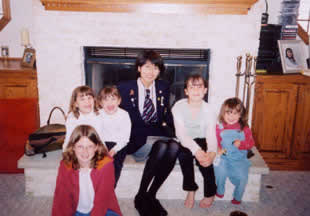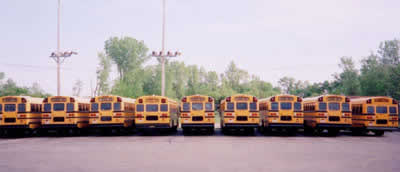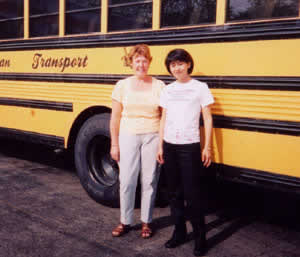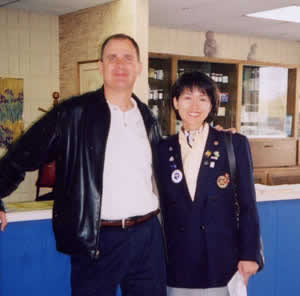
Director
Terazawa Acupuncture and Bone-setting Clinic
Sponsored by Settsu Rotary Club
Introduction
I recently visited Wisconsin in the United States of America as a GSE team
member under the sponsorship of the Settsu Rotary Club.
Before leaving for Wisconsin, I heard from former GSE team members that my
GSE trip would be more wonderful than anything I had ever experienced in my
life, and they were right.
My GSE trip started with the preparations that had to be made prior to my departure.
First, I had to find a way to open up a month-long block of time in my work
schedule. I started looking for and lining up doctors who could fill my position
while I was away in November of last year, and it was a rather courageous undertaking.
Why did I go to so much trouble to take part in the GSE program? The reason
is that I had been interested in going to America even before I heard about
the GSE program, and I would be able to see with my own eyes how they carry
out alternative medicine and medical treatment in America. Also, realized that
I would never have such a wonderful chance as this, where people who are so
knowledgeable regarding work and the world as Rotarians would be organizing
my entire schedule and taking care of all my needs!
Also, I thought that this trip would be a good means of testing myself. How
flexible would I be when encountering things I knew little about? How much would
I be able to open up with people I had never met in my life? Could my body handle
the strain? How much would this one-month trip change me? And more. I would
be tested and tried in every way.
I departed the Kansai International Airport on May 1, 2002 with both expectation
and uneasiness in my heart, wondering just what would happen in Wisconsin.
After arriving in Wisconsin, I was treated so warmly and kindly by the various
Rotary clubs and Rotarians that I met that I began to wonder if it was really
all right for me to be on the receiving end of such hospitality and kindness.
The many people I met at the various places I visited were all so great, and
I have such a wonderful impression of America now.
I am so grateful for being allowed to meet so many wonderful people, to see
so many different things, and to have such irreplaceable, precious experiences.
I would like to take the opportunity now to give a simple report on my experiences
to the Japanese Rotary clubs and Rotarians who supported and assisted me, and
to all those who cooperated to make this trip possible.
My Host Families
Seven families opened their homes to me during my month in Wisconsin. My first
two hosts, Bob Hosch and Gary Olsen, are both past governors, so they were very
good at getting me, who was very nervous and unsure of things, to relax and
take it easy.
I had never had a homestay experience before this, and had almost never stayed
at another personユs home even in Japan, so this was a very worrisome time for
me at first. But, I found out that there was absolutely no need for me to worry.
I was so thankful that everyone welcomed me so calmly and casually. It was so
natural for them, and they treated me like their own daughter. I felt they were
watching over me warmly and I was able to spend my time with them with a real
sense of security. In particular, I was so moved when Mrs. Olsen helped me with
the TV remote control. I had no idea how to use it, and when I mentioned it
to her, Kathy got a piece of paper and drew a picture of the control, explaining
how to operate it.
 With Gary and
Kathy Olsen (at their home)
With Gary and
Kathy Olsen (at their home)
The hosts at my third home were Brian and Brenda Guerin. Brian works at an
insurance company, and he and his wife have four small children. I have wonderful
memories of my time with them. On Sunday, we went to church and the movies,
and in the evening Brian and Brenda read stories to their children. As they
read, they helped the children with their pronunciation, and since I was the
first Japanese person they had ever met, the children were very interested in
asking me questions.
 Surrounded by
Brian's children
Surrounded by
Brian's children
In Oshkosh, I had homestays with two different chiropractors. The first was
Dr. Jerry Hendrickson, a veteran chiropractor. The second was Dr. Kim Johnson,
who just opened up her own clinic about four years ago. She is married to a
lawyer and they have two small children.
I think I was very lucky to be able to stay with a woman chiropractor who has
her own clinic. I feel this way because in Japan, I am in a basically similar
position as she is, and, as women, we encounter many similar problems related
to our work. It was great to have the chance to listen to the opinions of someone
like Kim, who is working in a country that is more progressive than Japan in
regard to women in the workforce. I was also able to see how she lives her daily
life.
Kim works four days a week (Mondays, Tuesdays, Thursdays, and Fridays) from
10:00 to 5:00. She could surely make more money if she worked more, but she
said that family time is very important to her, and she works much less than
she did before she got married.
Her husband, who is a lawyer, is very supportive of her working and cooperates
with her a lot in this regard. Also, he is very proud of the fine work that
she is doing. Kim is a very energetic person, and she is active not just in
her work and at home, but also in the Rotary and in a volunteer group involved
with helping women get started in business.
It was a good feeling for me to see such a doctor, whose beautiful nails are
done once a week, looking at patient after patient in a fashionable pantsuit
(it seems like she never wears a white doctor's smock).
My next homestay was with the family of Wisconsin GSE team leader Erik Moeser,
in Port Washington. When I arrived at his home, Erik immediately served me Japanese
green tea and Japanese snack food. While I was filled with a feeling of relief
savoring Japanese tastes, I was also filled with doubts about whether it was
all right to receive such hospitality from an American. Relieved? As I thought
about it, it was a rather strange and interesting experience. Later, I felt
it was rather funny.
While I was in Port Washington, Erik served as my chauffer almost every day,
and he organized my schedule. Even though he was very busy helping me out, while
I was there he took the time to edit and organize the digital camera photos
he had taken in Japan, and gave copies to all of the Japan GSE team members.
He treated all the Japan team members equally, greeting us all, showing concern
for all of us, and staying close by to make sure we had everything we needed.
My last homestay was in Heartland. Magda Dimmendaal impressed me greatly. Magda
is a Rotarian, whose bus company operates the familiar yellow school buses we
associate with American schools. In Wisconsin, everyone has beautiful yards,
but Magdaユs (whose hobby is gardening) was absolutely wonderful.
Her large yard was more like a park, with a man-made pond and a white, two-person
pedal-boat. There were small fish and some turtles living in the pond. Magdaユs
son and grandchildren sometimes pitch a tent in her yard and have fun sleeping
out there with a campfire. (I think this gives you an idea of just how big her
yard is!)
On her days off, Magda and her husband, Paul, worked in their vegetable garden
and flowerbeds. They put out oranges, jam and other things on the wooden deck
of their home to attract wild birds. I was able to get a close-up look at some
very beautiful birds and birds with very unique ways of flying. In addition
to that, there were also wild deer and squirrels coming into her yard. It was
like a dreamland to me. On the last day before I returned to Japan, Magda even
gave me a ride in one of the bright yellow school buses that the children take
to and from school every day.
 Magda's school
buses
Magda's school
buses
 With my hostess,
Magda
With my hostess,
Magda
In just four weeks, I was given the opportunity to stay with seven different
types of families. I was treated very warmly at each home, and it was truly
wonderful to experience the feel of daily life in real American homes. These
were all things that I could never have experienced if I had visited America
simply as a tourist.
My Feelings of Daily Life in Wisconsin
While I was in America, the question I was asked most often was this: What
is the biggest difference between Japan and America?
As I see it, everyone in America knows exactly what is most important to him/her
and what he/she needs. In other words, they are very clear about what they should
spend their money on and spend their time doing.
I also felt that married couples get along so well. I have heard that there
is a lot of divorce in America, but what I experienced made it hard to believe.
It may be that Americans faithfully follow their feelings; if they love each
other they are true to them, and if they lose their love, well, they...
Also, since everything there is so big, it was a nice feeling. The cars, the
roads, the people, the homes, the food, the clothing, ノ everything. In particular,
the dresses were great. In Japan, I wear an L-size, but in the United States,
I am an S-size. Some of the things I tried on were even XS-size! On top of that,
the prices were 30% or 40% cheaper than in Japan.
Also, no matter what we were doing, people were very friendly and informal.
During our presentations and the many parties we attended, we were never made
to feel nervous. Everyone always made sure we all had a good time. The parties
were always lots of fun, and it was very educational to see how to host a home
party and to see what such parties should be like.
I also thought it was nice that everyone had family photos and pet photos on
display in their homes and at their offices. I liked the colorful store displays,
and felt the interior decorating in the buildings and offices was very sharp.
Moreover, the systems I saw were very rational, with little waste, and it was
very clear who was responsible for what.
It was such an interesting thing being able to feel firsthand so many different
things in America.
Vocational Study
In both Japan and the United States, alternative medical treatment, such as
that found in Oriental medicine, is receiving more and more attention. Alternative
medicine-related information from overseas finds its way into Japan in various
forms.
I work in Japan as a chiropractor, aroma therapist, acupuncturist, bonesetter,
masseuse, and medical counselor, and I do all of these things more or less based
on my own theory and technique. For this reason, I was very much looking forward
to having contact with chiropractors in the United States, who are far more
advanced than here in Japan.
Also, I had requested that I be able to visit a clinic specializing in acupuncture,
and related medical facilities.
The educational system
In America, in most states, chiropractors and acupuncturists are required to
receive training in order to obtain a license to practice alternative medicine.
There is also a system for license renewal, and it seems that, depending on
the state, such medical practioners are obligated to obtain a very high knowledge
and mastery of the techniques in order to obtain or maintain their medical license.
In Japan, once we obtain a license, there is no system in place to ensure that
we keep up with the newest information and continue to improve our technique.
Also, American chiropractors are able to take X-rays to assist them in their
diagnosis, it is possible for them to make the necessary evaluations of the
X-rays of cervical vertebrae to determine the best treatment. I heard that at
chiropractic universities, students get very practical training on how to use
and evaluate X-rays.
The medical insurance system
The largest difference between Japan and the United States is the fact that
in America, there is no national health insurance or social insurance provided
by the government. In America, there are many types of health insurance being
offered by both insurance companies and non-profit organizations. In other words,
medical insurance types in America are as plentiful as life insurance and accident
insurance types in Japan.
The cost and coverage provided are different from policy to policy, and the
better the coverage, the more the policyholder must pay. The insurance company
a family chooses depends upon their medical history, past illnesses, the region
in which they live, etc. If a family or person pays for their insurance themselves,
an inexpensive policy will cost at least $180 a month for a single person, and
about $450 a month for a family.
Right now in America, there is a big problem with what to do with those who
get sick and have no insurance because of its high cost and their low incomes.
Seeing American chiropractors and acupuncturists at work
As far as the degree to which acupuncture is recognized in America, there are
only a few people in the region I visited (the Midwest) who have actually received
acupuncture treatment. I heard that on the West coast and in New York, where
there are large numbers of Asians, recognition is high and there are many clinics.
Also, it is probably only natural, but I felt that the problems associated
with operating a clinic, treatment problems, and many of the symptoms encountered
by the patients are exactly the same as I face here in Japan.
The implements and equipment used during treatment are basically the same as
those used in Japan, but no matter what clinic one visits, materials (videos,
pamphlets, posters, etc.) explaining the procedure to the patients were in abundant
supply (doctorユs profile and work history, explanations about various symptoms,
the treatment provided, and things to be careful of in daily life after receiving
treatment).
Also, the first thing that shocked me when I visited a chiropractic clinic
was how extremely friendly everyone was towards one another (the doctors, their
assistants, and the patients). It seemed as if the patients felt like they were
visiting an old friend. The doctors would hug patients who had made progress
and rejoice together with them.
But, as I observed the patients, I also noticed that they were frank in expressing
not just their joy, but also their uneasiness and dissatisfaction with the treatment
received. Communicating clearly and effectively, and saying what needs to be
said frankly and in a short time. I felt this was really the American way.
 With veteran chiropractor
Jerry Hendrickson
With veteran chiropractor
Jerry Hendrickson
I also noticed that in America, the computer software used at the clinics is extremely good, enabling the doctors to keep electronic charts for their patients, to organize patient data, and to carry out measurements and tests with great efficiency. I was very envious of them.
In Conclusion
The GSE program is a truly unique and wonderful program. After returning to
Japan, I realized that it was a wonderful opportunity for me to take a second
look at Japan, my occupation and myself.
Also, depending on how much a participant seeks to get out of the program,
there is much to be obtained. I consider myself very lucky to have been blessed
with the chance to take part in the GSE program.
I want to express my heartfelt thanks to everyone who enabled me to have this wonderful experience: all my host families in Wisconsin, the GSE committee members of both D-2660 and D-6270, all the Rotarians who helped out in the program, my team leader, Yoshikazu Satoh, team members Kuniyuki Tosa, Tatsuya Tamai, Yuki Ota, the staff at my clinic who gladly allowed me to take the time off, and my family.